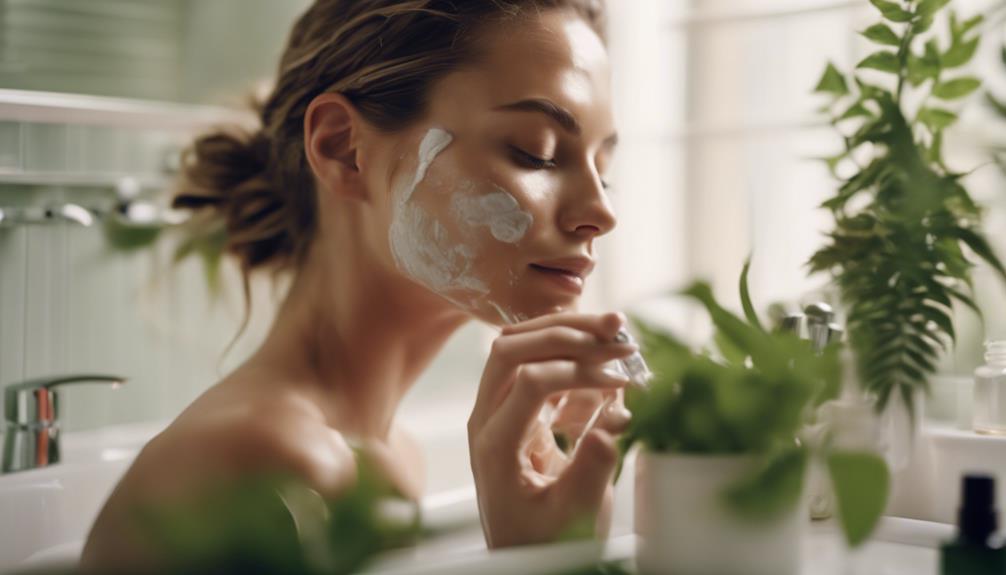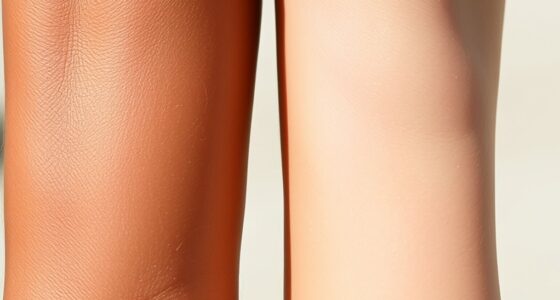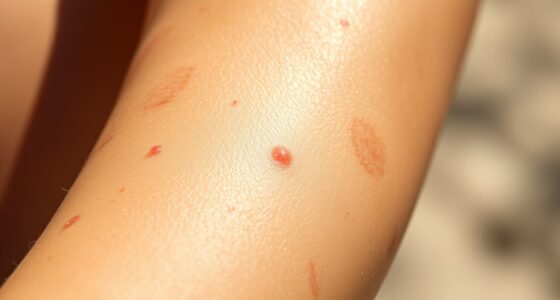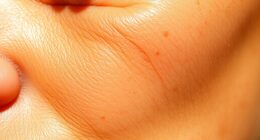To get rid of dark spots, start with topical treatments like vitamin C, hydroquinone, and kojic acid, which can brighten your skin by inhibiting melanin production. Apply these products consistently, using sunscreen daily to protect against UV rays that worsen pigmentation. If you're seeking faster results, consider professional options like chemical peels or laser treatments. Regularly consult with a dermatologist to tailor your approach and monitor your progress. Keeping a journal or documenting your skin's response can also help you track improvements. There's much more to discover about achieving a clear complexion, so stick around for further insights!
Key Takeaways
- Use topical treatments with active ingredients like Vitamin C, hydroquinone, or azelaic acid to target dark spots effectively.
- Apply sunscreen daily (SPF 30 or higher) to prevent further pigmentation and protect your skin from UV damage.
- Consider professional treatments, such as laser therapy or chemical peels, for more significant results on stubborn dark spots.
- Maintain a consistent skincare routine that includes gentle exfoliation and antioxidants to promote skin health and reduce hyperpigmentation.
Understanding Dark Spots
Dark spots, or hyperpigmentation, occur when your skin produces too much melanin, often due to factors like sun exposure or hormonal changes.
These dark spots can appear as various types, including melasma, which manifests as dark patches on the face, usually triggered by hormonal fluctuations. Sun exposure is a common culprit for age spots, also known as liver spots, that develop after prolonged time in the sun.
You might also encounter post-inflammatory hyperpigmentation (PIH), which arises after skin injuries, acne, or skin inflammation, leaving darker patches where the skin has healed.
It's vital to understand that while all skin types can develop these dark spots, individuals with darker skin tones tend to be more prone due to their higher melanin levels.
As you age, the risk of dark spots increases, as the melanin-producing cells in your skin become enlarged and more concentrated.
This overproduction of melanin can result in uneven skin tone, making it important to protect your skin from sun exposure and be mindful of hormonal changes that could contribute to hyperpigmentation.
Understanding these factors is the first step toward effectively addressing dark spots.
Topical Treatment Options

When it comes to treating dark spots, understanding the active ingredients in topical treatments is essential.
You'll want to apply these products correctly to maximize their effectiveness, while also keeping safety in mind.
Let's explore these key points to help you achieve clearer skin.
Active Ingredients Overview
Understanding the various active ingredients in topical treatments can help you effectively target and reduce dark spots on your skin.
Vitamin C is an excellent choice, as it acts as a powerful antioxidant that inhibits melanin production, helping to brighten those pesky dark spots while maintaining your skin's overall tone.
Kojic Acid, derived from mushrooms, also suppresses pigment cell activity, but be cautious, as it can cause allergic reactions in some individuals.
Azelaic Acid is another versatile option; it not only tackles hyperpigmentation but also treats acne, interfering with abnormal pigmentation production. You can apply it once or twice daily for the best results.
Retinol, a derivative of Vitamin A, promotes cell turnover and stimulates collagen production, making it effective in reducing dark spots over time while enhancing your skin's texture.
For more immediate results, consider skin-lightening products containing Hydroquinone, which inhibits melanin production and can show visible improvement within 8 to 12 weeks.
Combining these ingredients in your routine can lead to significant improvements in the appearance of dark spots and overall skin health.
Application Techniques
Effective application techniques for topical treatments can greatly enhance your results in reducing dark spots and promoting a more even skin tone.
Start your morning routine by applying vitamin C serums on cleansed skin before sunscreen. This not only protects against UV damage but also combats free radicals.
For hydroquinone, apply it directly to the dark spots—over-the-counter options with up to 2% concentration are safe for daily use. Kojic acid is best applied at night, targeting those specific areas; begin with a low concentration to avoid skin irritation.
When using azelaic acid or soy extracts, apply them once or twice daily before your moisturizer to help brighten your skin tone.
If you're opting for chemical peels, verify you follow the instructions closely: apply them on clean, dry skin, and always moisturize afterward to prevent dryness and irritation.
Additionally, consider incorporating hyaluronic acid into your routine; it hydrates and enhances the effectiveness of your topical treatments.
Safety Considerations
Starting any topical treatment for dark spots requires you to prioritize safety through patch testing and consulting with a dermatologist. This step helps you assess skin sensitivity and avoid potential allergic reactions.
Ingredients like hydroquinone, while effective for reducing hyperpigmentation, can lead to side effects such as dryness and irritation. It's essential to use these active ingredients only under the guidance of a dermatologist.
Consider safer alternatives like kojic acid and azelaic acid, which are generally better tolerated but may still cause irritation, especially on sensitive skin. Always perform a patch test on a small area before full application to verify your skin reacts well.
Moreover, when using topical treatments, applying sunscreen (SPF 30 or higher) daily is important. Many of these products can increase skin sensitivity to sunlight, which might exacerbate dark spots if you're not protected.
Consulting with a dermatologist before starting any potent treatments, like retinol or hydroquinone, is critical. They can provide tailored advice and monitor for any adverse effects, confirming your journey to clearer skin is both effective and safe.
Professional Treatment Methods

Professional treatment methods offer targeted solutions for reducing dark spots and can greatly enhance your skin's appearance. These options include laser treatment, chemical peels, microdermabrasion, prescription skin-lightening creams, and microneedling. Each method addresses dark spots in unique ways, often requiring multiple sessions for ideal results.
Here's a quick comparison of these treatment options:
| Treatment | Cost Range |
|---|---|
| Laser Treatment | $800 per session |
| Chemical Peels | $100 – $1,000 |
| Microdermabrasion | $100 – $600 |
| Prescription Creams | Varies by prescription |
| Microneedling | $300 – $1,750 |
Laser treatment uses focused light to break down melanin in dark spots. Chemical peels exfoliate the skin and promote new growth, while microdermabrasion removes dead skin layers. Prescription skin-lightening creams can effectively reduce melanin production over time, and microneedling stimulates collagen production for better absorption of topical treatments. Consider these professional options to achieve clearer, brighter skin.
Effective Ingredients for Brightening

Incorporating powerful ingredients into your skincare routine can considerably brighten your complexion and reduce the appearance of dark spots. These effective brightening agents target hyperpigmentation, helping you achieve a more even skin tone. Here are four key ingredients to evaluate:
- Vitamin C: This antioxidant blocks free radicals and inhibits melanin production, making it essential for fading dark spots when applied daily.
- Hydroquinone: Known as the gold standard for treating hyperpigmentation, it's available in both over-the-counter and prescription strengths, with results usually visible in 8 to 12 weeks.
- Niacinamide: This anti-inflammatory ingredient not only evens your skin tone but can also be combined with other brightening agents for enhanced clarity.
- Azelaic Acid: Effective for reducing abnormal pigmentation, it also has antibacterial properties, making it ideal for combating both hyperpigmentation and acne.
You might also explore Kojic Acid, derived from mushrooms, to suppress pigment cell activity.
Preventive Measures

To effectively prevent dark spots, daily application of a broad-spectrum sunscreen with at least SPF 30 is essential for protecting your skin from harmful UV rays. These rays trigger melanin production, leading to pigmentation issues. Make it a habit to apply sunscreen every morning, even on cloudy days.
In addition to sunscreen, consider wearing protective clothing like wide-brimmed hats and long sleeves when you're outdoors. This adds another layer of skin protection against direct sunlight, especially during peak hours from 10 a.m. to 4 p.m. Limiting your sun exposure during these times is vital.
Incorporating antioxidants into your skincare routine can also be beneficial. Products containing vitamin C help neutralize free radicals and reduce oxidative stress that contributes to dark spots. Regular gentle exfoliation promotes cell turnover, preventing the buildup of dead skin cells that can darken existing spots.
Expert Recommendations

When it comes to tackling dark spots, consulting a dermatologist is a smart move.
They can create a personalized treatment plan tailored to your skin's needs, ensuring you get the best results.
Consult a Dermatologist
Consulting a dermatologist is essential for pinpointing the exact cause of your dark spots and finding the most effective treatment. A healthcare professional can identify different types of hyperpigmentation and recommend tailored treatment approaches suited to your skin type.
Here are some ways a dermatologist can assist you:
- Diagnosis: They may perform tests like the Woods lamp examination to determine the nature of your dark spots.
- Prescription Treatments: Dermatologists can prescribe stronger options, such as hydroquinone, to effectively reduce melanin production over 8 to 12 weeks.
- Over-the-Counter Recommendations: They can suggest effective over-the-counter products containing ingredients like niacinamide and glycolic acid to help fade dark spots.
- Monitoring Progress: Regular follow-up appointments allow your dermatologist to monitor progress and adjust treatment plans based on how your skin responds to therapies.
Personalized Treatment Plans
Creating a personalized treatment plan for dark spots starts with a detailed evaluation by a board-certified dermatologist to identify the specific type of hyperpigmentation and its underlying causes. This initial assessment is vital in tailoring your treatment to achieve the best results.
Your dermatologist may recommend a combination of topical agents, such as hydroquinone or kojic acid, suited to your skin type and sensitivity. These options help minimize irritation while effectively targeting dark spots. Depending on the severity of your condition, professional procedures like chemical peels or laser treatments might also be part of your personalized treatment plans.
A thorough skincare routine is essential in supporting your treatment. This includes applying broad-spectrum sunscreen daily to protect your skin from further damage and using antioxidant-rich serums to boost your skin's health.
Ongoing monitoring of your progress is important, as your skin's response to treatments can vary. Regular follow-ups with your dermatologist guarantee that any necessary adjustments are made to optimize your regimen and enhance the effectiveness of your dark spot removal efforts.
Monitoring Progress and Results
Regularly evaluating your skin's response to treatments for dark spots helps you gauge their effectiveness and make informed adjustments.
To effectively monitor your progress and results, consider these key steps:
- Keep a diary: Note any changes in color, size, or texture of dark spots after starting treatments. This will help you track your skin's progress over time.
- Take before-and-after photos: Capture images every few weeks to visually assess fading pigmentation. This can reveal improvements that might be subtle day-to-day.
- Consult your dermatologist: Schedule regular check-ups to discuss treatment outcomes and tweak your skincare regimen as needed. Their expertise can guide you toward effective options.
- Watch for adverse reactions: Be alert for any increased redness, irritation, or new dark spots. If you notice these, it may signal the need to adjust or stop your current treatments.
Frequently Asked Questions
How Do You Get Rid of Dark Spots Scientifically?
To get rid of dark spots scientifically, you can use topical treatments like hydroquinone, kojic acid, or vitamin C. Professional options like chemical peels or laser therapy also help, often requiring multiple sessions for best results.
What Gets Rid of Dark Spots the Fastest?
To get rid of dark spots the fastest, consider professional treatments like laser therapy or chemical peels. Combine these with topical agents like vitamin C or hydroquinone for quicker, more effective results. Consistency's essential!
How Do You Permanently Fade Dark Spots?
To permanently fade dark spots, you should consistently use effective topical treatments, undergo professional procedures like chemical peels or laser therapy, and diligently apply sunscreen to prevent further darkening and protect your skin.
What Dark Spot Remover Really Works?
Finding the right dark spot remover feels like uncovering buried treasure. You'll discover products with hydroquinone or vitamin C really work, delivering noticeable results. Don't forget professional treatments for quicker, more dramatic outcomes that might suit you!
What methods can be used to get rid of dark spots and achieve radiant skin health?
Looking for radiant skin health tips? Try using chemical exfoliants like glycolic acid or lactic acid to fade dark spots. Incorporating vitamin C serums and retinoids can also help. Don’t forget to wear sunscreen daily to prevent further pigmentation. Consistency is key for achieving glowing, even skin.
Conclusion
In your journey to banish dark spots, remember that consistency is key.
With the right treatments and preventive measures, you'll transform your skin into a luminous canvas that radiates confidence.
Don't forget to celebrate small victories along the way; every step forward is a leap toward your ultimate glow!
So embrace these proven methods, and watch as those pesky spots fade away, leaving behind a complexion that shines brighter than the sun itself.









